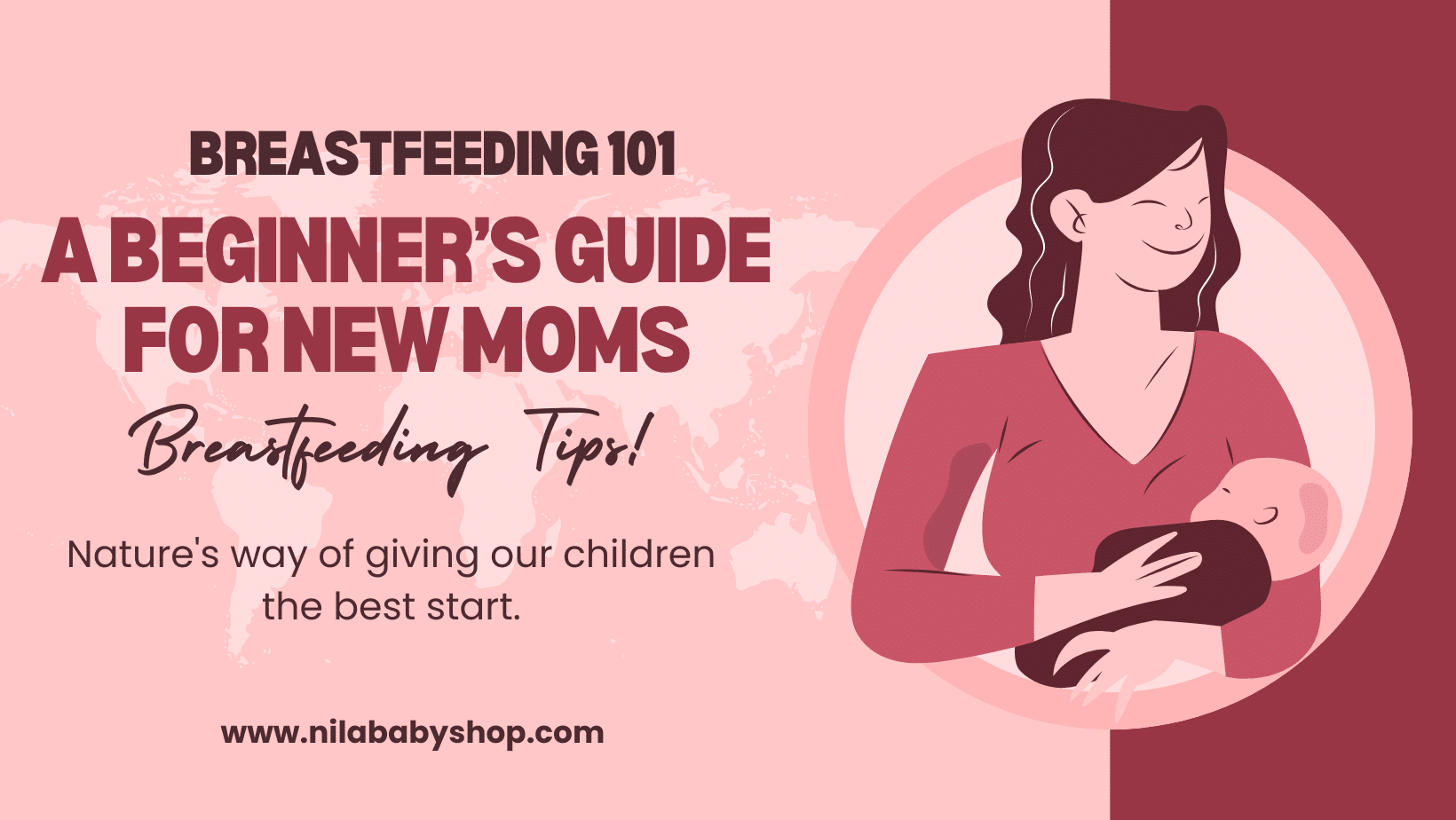
Nila Baby Shop
Empowering You with Knowledge and Confidence
Welcoming a newborn is a joyous yet overwhelming experience, especially when navigating breastfeeding. Whether you’re a first-time mom or refreshing your skills, this guide covers everything from positions to troubleshooting challenges—all designed to help you and your baby thrive.
Breastfeeding Basics: Getting Started

Breastfeeding is a natural process, but feeling unsure at first is normal. Here’s what you need to know:
- Benefits: Breast milk is tailored to your baby’s needs, boosting immunity, reducing risks of infections, and promoting bonding. It’s also cost-effective and always ready at the perfect temperature.
- First Steps: Initiate breastfeeding within the first hour after birth to stimulate milk production and bond with your baby. Skin-to-skin contact helps regulate their temperature and encourages feeding instincts.
- Milk Supply: Frequent feeding (8–12 times daily) in the early weeks establishes your supply. Let your baby nurse on demand—this signals your body to produce more milk.
Comfortable Breastfeeding Positions
Finding the correct position can make nursing easier. Try these:
- Cradle Hold: Classic and cozy. Support your baby’s head with your arm, keeping their body facing yours (“tummy to tummy”).
- Football Hold: Ideal for C-section recovery. Tuck your baby under your arm like a football, supporting their neck and shoulders.
- Side-Lying Position: This position is perfect for nighttime feeds. Lie on your side with your baby facing you, using pillows for support.
- Cross-Cradle Hold: Great for newborns. Use the opposite arm to support their head, allowing better latch control.
Pro Tip: Use a nursing pillow (like our NilaBaby Organic Nursing Pillow) to reduce strain on your back and arms.
How to Know If Your Newborn Is Hungry
Crying is a late hunger cue—look for these earlier signals:
- Early Signs: Lip-smacking, rooting (turning head toward touch), sucking on hands.
- Active Signs: Fussing, squirming, rapid breathing.
- Late Signs: Agitated crying, clenched fists.
Feed your baby at the first signs to avoid frustration and ensure effective latching.
Signs Your Baby Is Full
Overfeeding is rare with breastfeeding, but watch for these cues:
- Turns away from the breast or bottle.
- Releases the nipple and relaxes hands/body.
- Falls asleep (“milk drunk”) with a content expression.
- Stops swallowing and loses interest.
Trust your baby’s instincts—they’ll stop when satisfied!
How Long Should a Feeding Session Last?
Newborns typically nurse for 15–45 minutes per session, but this varies:
- Early Feeds: Focus on emptying one breast to ensure your baby gets fatty hindmilk, which is crucial for growth.
- Growth Spurts: At 2 weeks, 6 weeks, and 3 months, expect cluster feeding (frequent, short sessions) to boost supply.
Tip: Track feeds with the NilaBaby Nursing Tracker App (launching soon!) to monitor patterns.
Keeping Your Newborn Awake During Feeds
Sleepy babies? Try these tricks:
- Gently stroke their cheek or feet.
- Use a cool washcloth to wipe their face.
- Switch breasts midway to re-stimulate sucking.
Burping Your Baby: Yes or No?
Breastfed babies swallow less air but still benefit from burping:
- Burp after each breast or every 5–10 minutes during bottle feeds.
- Hold them upright against your chest or lap, supporting their chin.
Can You Overfeed a Breastfed Baby?
It’s uncommon, as babies self-regulate. However, bottle-fed babies may overeat if the flow is too fast. Use a slow-flow nipple and practice paced feeding.
Why Breastfeeding Can Feel Challenging
Common hurdles and solutions:
- Latching Issues: Pain or clicking sounds signal a poor latch. Consult a lactation consultant for adjustments.
- Low Milk Supply: Often temporary. Nurse frequently, stay hydrated and consider lactation supplements.
- Engorgement or Mastitis: Use warm compresses and massage. Seek medical help for fever or flu-like symptoms.
- Emotional Strain: Fatigue and anxiety are normal. Join support groups or book a virtual consultation with our certified lactation experts.
Final Tips for Success
- Educate Yourself: Attend prenatal classes or watch our Breastfeeding Masterclass (free for NilaBaby members!).
- Prioritize Comfort: Invest in a quality nursing bra and soothing nipple cream from our Postpartum Care Kit.
- Ask for Help: You’re not alone! Connect with other moms in our NilaBaby Community Forum.
Ready to Start Your Journey?
Visit www.nilababyshop.com for breastfeeding essentials, expert guides, and personalized support. Sign up today for FREE DELIVERY on all your orders!
Breastfeeding is a journey—not a destination. Celebrate every small victory, and remember: You’ve got this, mama! 🌸
Written by Nila Baby Shop
Best Baby and Mother Products Store. Our main objective is to provide an exceptional online shopping experience, home delivery, and prompt customer service.
Leave a Reply